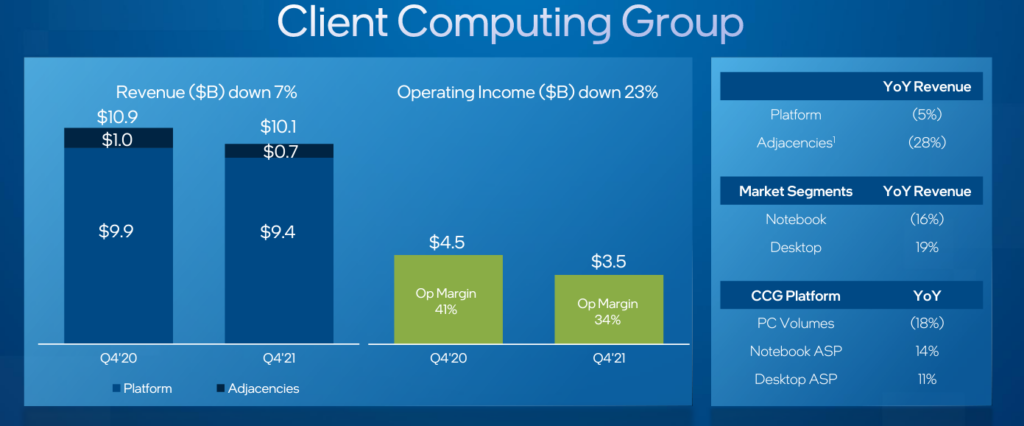Sales up, forecast down, revenue $20.5 billion, up 2.5% year over year.

Intel reported its fiscal year and fourth quarter results for 2021. The company beat Wall Street expectations on revenue, and gross margin, even though it was down from Q3’21. Hitting $20.5 marked the highest quarterly and full year revenue ever for the company. Intel advanced its IDM 2.0 strategy and announced a new U.S. manufacturing site in Ohio. It sold its NAND operation and announced its intent to take Mobileye public. The company raised its dividend 5%.

“Q4 represented a great finish to a great year. We exceeded top-line quarterly guidance by over $1 billion and delivered the best quarterly and full-year revenue in the company’s history,” said Pat Gelsinger, Intel’s CEO. “Our disciplined focus on execution across technology development, manufacturing, and our traditional and emerging businesses is reflected in our results. We remain committed to driving long-term, sustainable growth as we relentlessly execute our IDM 2.0 strategy.”

Intel listed their Q4’21 business highlights as:
- Announced plans to take Mobileye public in the United States in mid-2022 via an initial public offering of newly issued Mobileye stock.
- Completed the first closing of the sale of its NAND memory business to SK Hynix for $7 billion of the deal’s $9 billion.
- Announced initial investment of more than $20 billion to build two new leading-edge chip factories in Ohio, where the company is establishing the first advanced semiconductor campus in the Silicon Heartland of the Midwest. This will be Intel’s first new manufacturing site location in 40 years.
- Launched the 12th Gen Intel Core processor family, including the all-new 12th Gen Intel Core H-series mobile processors led by the Intel Core i9-12900HK, the fastest mobile processor ever created. The 12th Gen Intel Core family will include 60 processors and more than 500 designs.
- Unveiled key packaging, transistor, and quantum physics breakthroughs fundamental to advancing and accelerating computing well into the next decade and outlined its path toward more than 10× interconnect density improvement in packaging with hybrid bonding and 30% to 50% area improvement in transistor scaling.
- Began shipping Intel Arc discrete graphics products (code-named “Alchemist”) to OEM/ODM customers, with more than 50 design wins.
- Released the oneAPI 2022 toolkits to expand features to provide developers greater utility and architectural choice to accelerate computing.

Fourth-quarter revenue was led by an all-time record quarter for our Data Center Group (DCG), with strong server recovery in enterprise and government, said the company. The Internet of Things Group (IoTG) had a record quarter, reflecting strong demand on recovery from Covid-19 impacts. The Client Computing Group (CCG) delivered another $10 billion quarter, proving that PCs are more essential than ever.

Gelsinger added, “Q4 represented a great finish to a great year. We exceeded top-line quarterly guidance by over $1 billion and delivered the best quarterly and full-year revenue in the company’s history. Our disciplined focus on execution across technology development, manufacturing, and our traditional and emerging businesses is reflected in our results. We remain committed to driving long-term, sustainable growth as we relentlessly execute our IDM 2.0 strategy.” Business highlights include the announcement of initial $20 billion+ investment to build two new leading-edge chip factories in Ohio.

Outlook
For Q1’22, the company is forecasting a decline in sales to $18.3 billion, and decline in gross margin to 52%.

“We expect to see [product] constraints to continue through 2022 and into 2023,” Gelsinger said.
What do we think?
If the PC industry was acting normally, and it’s not, Q1 would normally be down and Intel’s forecast wouldn’t seem so bad. But nothing is behaving normally. If the rest of the industry follows Intel, then we’ll have a beet vision. AMD’s guidance will be important to see next week.





